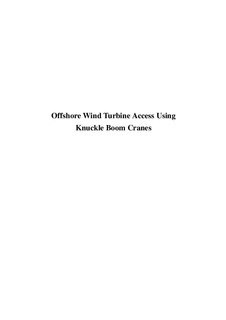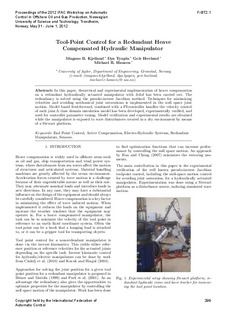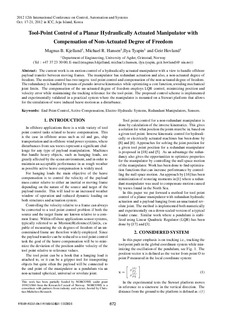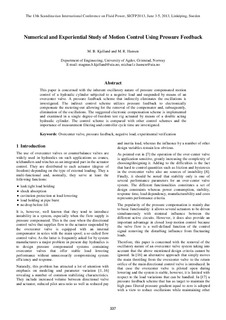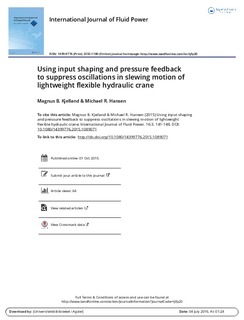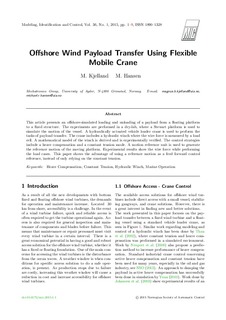| dc.contributor.author | Kjelland, Magnus Berthelsen | |
| dc.date.accessioned | 2016-10-24T12:24:55Z | |
| dc.date.available | 2016-10-24T12:24:55Z | |
| dc.date.issued | 2016 | |
| dc.identifier.isbn | 978-82-7117-836-9 | |
| dc.identifier.issn | 1504-9272 | |
| dc.identifier.uri | http://hdl.handle.net/11250/2417315 | |
| dc.description | Doktorgradsavhandling, Fakultet for teknologi og realfag, Institutt for ingeniørvitenskap, 2016 | nb_NO |
| dc.description.abstract | There is a great need for renewable and sustainable energy today and there are several
different sources for this energy where offshore wind is one that has a great
estimated planned power production. Wind power production has for many years
been produced onshore, but installing the wind turbines offshore has some benefits
due to higher and more stable wind conditions. The majority of installed wind turbines
are today bottom fixed, but when moving to deeper waters it is too high cost
in building and installing foundation, which brings the possibility of using floating
wind turbines. There are, however, also challenges due to the access for both the
fixed and floating offshore wind turbines. During startup, repair or maintenance
there is a demand for easy access of both personnel and equipment.
This dissertation mainly deals with offshore access solutions systems or parts of
those systems. The access solutions are systems that transfers personnel or equipment
from a floating vessel to a fixed or floating offshore structure.
Work done using a small scale hydraulic manipulator is described in Papers
A and B, where paper A deals with the kinematic motion control of such a small
scale redundant manipulator mounted on a moving Stewart platform, imitating the
motion of a floating vessel. The manipulator tries to keep the tool point at a fixed
reference point by the use of the pseudo-inverse Jacobian. Used in the experimental
verification is a high precision laser tracker which measures the position of the tool
point. Paper B uses the same manipulator and has in addition a hanging payload attached to the tool point. A LQR control strategy is used to minimize the vibration
of the hanging payload when the manipulator moves the tool point relative to a
ground fixed coordinate system.
Paper C is concerned with the inherent oscillatory nature of pressure compensated
motion control of a hydraulic cylinder subjected to a negative load and suspended
by means of a counter-balance valve. The method proposed in this paper has the
focus on pressure feedback and is compared to classical control strategies.
In paper D input shaping is used for the slewing motion control of a full scale mobile
crane. The flexibility of the crane causes vibrations when slewing and by knowing
the natural frequency and damping, the command signal is shaped so there are no
residual vibrations. Experimental verification is carried out by means of a laser
tracker.
Finally, the work done in Paper E deals with active heave compensation from a
fixed structure to a floating vessel. Modeling of the hydraulic winch is done and
a frequency response function is obtained. The active heave compensation was
experimentally verified using the full scale mobile crane as the fixed structure with
a winch mounted on it and the Stewart platform as the moving structure. Both
results from active heave compensation and constant tension are presented. The
payload in the experiments is a 400kg steel structure. | nb_NO |
| dc.language.iso | eng | nb_NO |
| dc.publisher | Universitet i Agder / University of Agder | nb_NO |
| dc.relation.ispartofseries | Doctoral dissertations at University of Agder; | |
| dc.relation.ispartofseries | ;142 | |
| dc.rights | Navngivelse-Ikkekommersiell-DelPåSammeVilkår 3.0 Norge | * |
| dc.rights.uri | http://creativecommons.org/licenses/by-nc-sa/3.0/no/ | * |
| dc.title | Offshore Wind Turbine Access Using Knuckle Boom Cranes | nb_NO |
| dc.type | Doctoral thesis | nb_NO |
| dc.subject.nsi | VDP::Technology: 500 | nb_NO |
| dc.source.pagenumber | IV, 78 s. | nb_NO |
